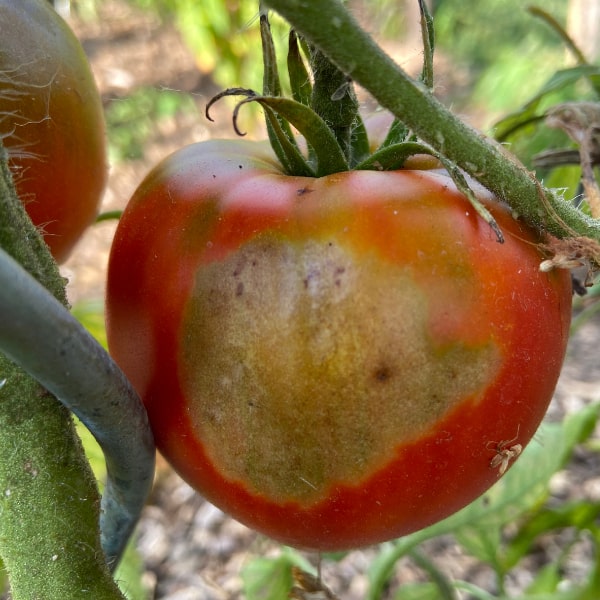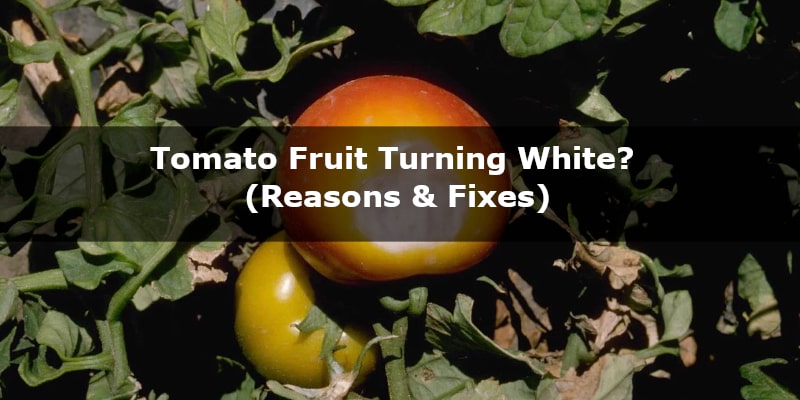I plant tomatoes almost every year.
I’ve dealt once with tomato fruits that turned white. In this article, I’ll tell you what’s the problem, and what you can do about it.
Why is Tomato Fruit Turning White?
Your tomato fruit might be turning white because of a few reasons, but the most probable one is sunscald. It’s a condition when tomatoes are exposed to the direct rays of the sun for too long.
White tomato fruits are occurring, because the fruits get too much sun, and the weather is dry. However, that’s not the only reason.
Your tomatoes might have the Spotted Wilt virus, Gray Wall, or they’re infected with Stink Bugs.
To find out the exact cause, keep on reading the article.
Sunscald
Sunscald is a condition common to tomatoes when they are exposed to the direct rays of the sun during hot and dry weather. The condition causes pale white or yellowish blotches on the fruit where the sun’s rays are most intense. Sunscald can affect mature tomatoes, but it’s more common on developing fruit.
Sunscald is especially prevalent when maturing fruit suddenly becomes exposed to the direct rays of the sun, often after the removal of foliage, or when there’s a lack of nitrogen.
As the fruit ripens, the affected area may become blistered before it finally turns thin, wrinkly, and paper-like in appearance. At this stage, the fruit becomes more susceptible to secondary fungal problems.

Once the sunscald appears, you can’t save the fruit. It’s recommended to remove affected fruits.
The best thing is prevention. To prevent sunscald on other tomato plants, remember to grow tomato plant varieties that have heavy foliage that can protect the fruits from the sun’s rays during intense heat. Also, maintain a level of shade cover over fruit as long as possible.
Spotted Wilt
Tomato spotted wilt virus affects tomatoes and more than 1,000 plant species.
The symptoms include young leaves developing lots of yellow to brown circular spots on the upper side. Drooping leaves make the plant look wilted. Affected plants also have dieback of the growing tips, stunted growth, and leaves that roll upwards or downwards.
Tomato plants that have tomato spotted wilt are either stunted or only grow on one side. Tomato fruits are deformed, and ripen unevenly, with chlorotic concentric blotches and bumps.
Spotted wilt virus is distributed by thrips. They pick up the virus when feeding with their sucking mouthparts on an infected plant. The virus then replicates in the insect body and remains in there for the rest of the insect’s life, transmitting it on an ongoing basis to healthy plants when feeding.
There is nothing you can do to save an infected tomato plant.
Remove an infected plant promptly, to avoid the disease from spreading to other healthy plants. You should also prevent the disease in the future.
First, buy only virus-free seedlings from a reputable nursery. However, you should always inspect the young plants carefully for signs of the disease, as well as thrips.
Second, practice good weed control. Don’t just weed in your garden but also around it to remove any weeds that are potential host plants for both the thrips and virus, such as dandelion, annual sowthistle, chickweed, or buttercup.
Moreover, wash your hands and disinfect tools as you move from infested to non-infested areas to prevent spreading the virus.
Gray Wall
Gray wall on tomatoes, also called blotchy ripening, is a physiological condition associated with environmental factors. The condition affects tomato fruit during the ripening process.
Tomatoes look splotchy, mottled, or unevenly ripened. Outward grayish splotches on tomato surfaces may even collapse inward. The inside of an affected tomato may also have whitish, grayish, yellowish, brownish, or greenish patches.
Gray wall develops most often on green tomatoes.
Factors that contribute to Gray Wall include extreme heat, high humidity, fluctuating temperatures, fog, excessive nitrogen, or overly wet soil.
To prevent Gray Wall, test your soil each year and amend nutrients accordingly. Also, use a balanced tomato fertilizer that doesn’t have excessive nitrogen (buy here on Amazon). A good idea is to plant varieties that are resistant to tomato Gray Wall.
Stink Bugs
Stink bugs are pests that infest tomato plants and destroy fruit. When threatened, these pests expel a repellent odor from their thoracic gland for which they are named.
These bugs are about ½ inch (1.3 cm) long, brown or green color, with a shield-like shape.
These pests insert their snouts underneath tomato skin. The enzyme they leave at the sting point turns that area of the tomato into liquid. The bug then drinks the liquid. Sting points produce dark pinprick marks on the tomato. Discolored areas appear on tomatoes where fluid is removed. They’re often white, yellowish or light green.
You can control these bugs by controlling weeds, hand-picking them, and treating them with insecticide (buy here on Amazon).
Prevention is also important. You should remove as many weeds and unnecessary garden foliage as possible, as Stink Bugs hide in dense foliage. When setting out seedlings in the garden next spring, allow extra space in between tomato plants to give extra circulation.
Sources
gardeningknowhow.com, joegardener.com, thespruce.com, tomatodirt.com

